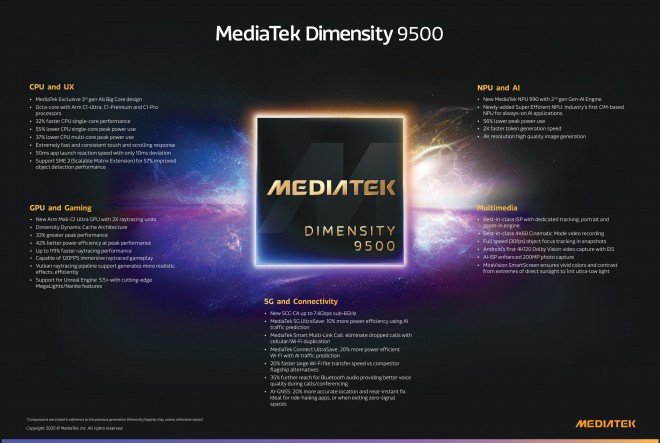On September 22, 2025, MediaTek officially announced its most ambitious mobile chipset to date: the Dimensity 9500. With this launch, MediaTek is aiming squarely at the premium segment—and to challenge the dominance of Qualcomm and Apple in the high-end smartphone space.
Here’s an in-depth look at what the Dimensity 9500 offers, how it stacks against competitors, and why it could shape the next wave of flagship phones.

Key Specifications & Technical Highlights
CPU & Architecture
- The Dimensity 9500 uses an All-Big-Core architecture built on TSMC’s N3P 3nm process.
- Its CPU layout is: 1 × C1-Ultra core @ 4.21 GHz, 3 × C1-Premium cores @ 3.5 GHz, and 4 × C1-Pro cores @ 2.7 GHz.
- MediaTek claims a 32% gain in single-core performance and a 17% improvement in multi-core workloads compared to its predecessor.
- At peak, the Ultra core achieves up to 55% lower power consumption for same performance tasks.
GPU, Gaming & Graphics
- The chipset features the Arm Mali-G1 Ultra GPU, delivering up to 33% higher peak performance and 42% better efficiency over prior-gen GPUs.
- MediaTek emphasizes console-class gaming, supporting hardware ray tracing and up to 120 fps rendering in select titles.
- Integration with Unreal Engine 5.5 / 5.6, Vulkan Ray Tracing pipelines, and MegaLights / Nanite support for high-fidelity environments is part of the package.
NPU & AI Capabilities
- The NPU 990, paired with the 2nd-gen Generative AI Engine, doubles compute for AI tasks, enabling 4K image generation on-device and faster token generation.
- A “Super Efficient NPU” with Compute-in-Memory (CIM) design allows always-on AI models at very low power.
Storage, Memory & Cache
- Supports 4-lane UFS 4.1 storage, which doubles read/write throughput vs earlier UFS versions.
- Uses a “Dimensity Dynamic Cache Architecture” combining CPU / GPU / NPU data caches and SLC management for low-latency performance.
- Cache setup is generous: 16 MB L3 cache and notable system-level cache for offloading.
Connectivity & Other Features
- Integrated modem supports 5G with 5CC carrier aggregation, enabling 7.4 Gbps downlink (sub-6GHz) speeds.
- Wi-Fi 7, Bluetooth 6, AI-GNSS (for more accurate location), and improved wireless power efficiencies are also included.
- On imaging front: support for 200 MP photos, RAW-domain pre-processing, 30 fps continuous focus, and 4K/120fps Dolby Vision video capture.
Performance in Benchmarks & Real-World Use
- Early leaks suggest Geekbench scores around 4,007 (single-core) and 11,217 (multi-core), which are significant uplift over the Dimensity 9400 series.
- In gaming and GPU-heavy tasks, gains in ray tracing performance (up to ~119% boost) are highlighted as a core strength.
- MediaTek claims the 9500 is ~30% more power efficient in multitasking scenarios (e.g., gaming + social apps) compared to its older generation.
These metrics, if matched in real devices, could put it on par or ahead of rival flagship chips in key workloads.
Positioning, Competition, & Device Ecosystem
- The Dimensity 9500 is designed to rival Snapdragon 8 Elite Gen 5 and potentially compete with Apple’s A-series chips in certain firing tasks.
- MediaTek’s decision to launch the 9500 just one day before Qualcomm’s competitor announcement suggests a strategic timing battle.
- OEMs like OPPO and Vivo are already expected to adopt the 9500 in upcoming flagships (e.g. OPPO Find X9, Vivo X300).
- The jump in AI & imaging capabilities may also influence how future smartphones market themselves—not just on speed, but what they can “think” or create on-device.
Potential Challenges & Considerations
- Pushing high performance while managing thermals and sustained workload performance will be critical. The “peak” numbers are impressive, but throttling behavior matters.
- Real-world GPU and ray tracing performance depend heavily on software and game support—rarely do all titles immediately exploit new hardware.
- Power efficiency claims need to be validated in actual devices with batteries, displays, radios, etc.
- Competition from Qualcomm, Apple, and perhaps newer architecture chips may erode the advantage unless ecosystem support is strong.
Why This Matters for the Market & Users
- The Dimensity 9500 is a bold move by MediaTek to reclaim respect in premium mobile silicon.
- If the chip delivers as promised, we may see phones that push the boundaries in mobile AI, real-time image generation, and console-grade gaming.
- For consumers, this might mean devices that feel smarter, more responsive, and capable of workflows that currently lean on cloud resources—moving more to on-device processing.
- For the smartphone industry, it raises the bar: the next wave of flagships may no longer compete on just camera or battery, but on what they can compute independently.
Also Read More: Microsoft Unveils Windows 11 25H2 RTM ISO — Download in 38 Languages for x64 & ARM64

